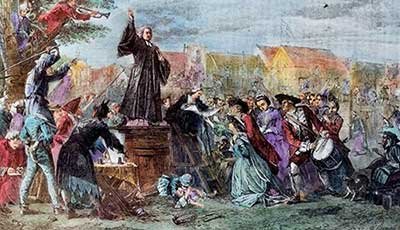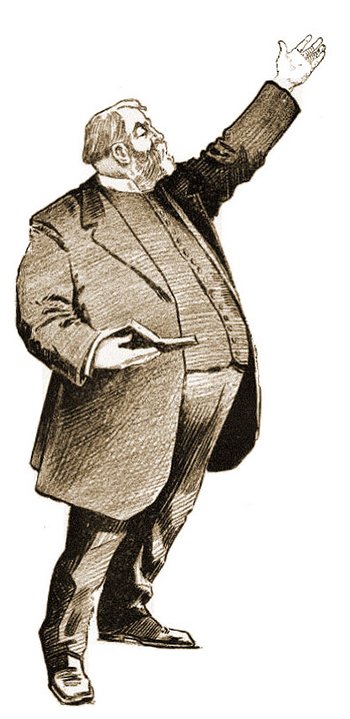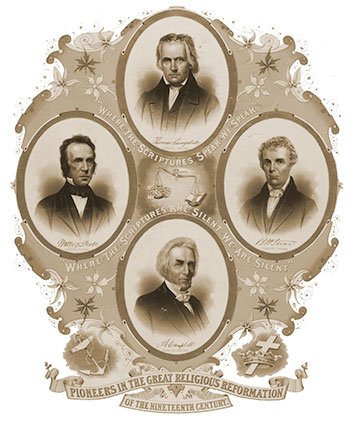18th Century Revival Heroes

Whitefield preaching
This century saw the First Great Awakening that hit Germany, North America and Great Britain fairly simultaneously from 1727, with intermittent revivals from 1742- followed by the beginning of the Second Great Awakening from 1792.
Pietists
The initial seeds of revival were sown by the Pietists, a people’s movement which emphasized an internal and individual return of the soul to the authority of the Bible, to prayer and to piety. It was birthed in mid-17th century by the ‘Father of Pietism,’ Philipp Jakob Spener, and his protégé August Hermann Francke. Franke, a professor in the University of Halle, had immense influence across Europe and America at the end of the 17th century.
Early Revivals in America and Germany
Early revivals were recorded 1679, 1683, 1696, 1712 and 1718 under Solomon Stoddard, Jonathan Edwards’s grandfather, pastor of Congregational Church in Northampton. In 1726 William Tennent began the Log College, producing many revivalist preachers, including his son’s, Gilbert and William Tennent.
In 1727 Theodore Frelinghuysen, a Dutch Reformed Pietist, saw revival in Dutch Reformed churches of the Raritan River Valley in New Jersey.
In 1739 Samuel Blair became pastor of Fagg’s Manor, 40 miles southwest of Philadelphia, and set up a school similar to Tennent’s Log College Tennent. Two notable students were James Finley and Samuel Davies, the organizer of Presbyterianism in Virginia.
In Herrnhut, Saxony (Germany) at the end of the 17th century Count Nicholas Zinzendorf was instrumental in the Moravian revival on August 13, 1727.
The most well-know revival occurred at Northampton, Mass., under Jonathan Edwards. The revivals was regularly fuelled and advanced by George Whitefield’s visits.
In 1763 Devereux Jarratt‘s revival ministry began, laying the foundation for Methodism’s greatest growth between 1763 and the Second Awakening in the 1790’s.
Francis Asbury, America’s greatest Methodist leader was sent to America in 1771 pushing the Methodist revival throughout the southern colonies, alongside Thomas Coke.
18th Century Revival Heroes in British Revivals
Griffith Jones, a young Anglican clergyman, was called the ‘morning star of the revival’ in Britain, together with Daniel Rowlands and Howell Harris, Wales was swept with revivals.
William M’Culloch was used to bring revival to Cambuslang, Scotland, helped by George Whitefield’s visit and James Robe saw a similar outpouring at Kilsyth
John Welsey, encouraged by Whitefield, began preaching in the open air to crowds of two hundred, then five thousand, then ten thousand, and even twenty thousand, in Bristol. Thereafter, his revivalistic ministry spread across every corner of Britain.
Other UK revivalists included William Grimshaw of Haworth, Yorkshire, Samuel Walker of Truro, William Romaine in London and John Berridge at Everton.
The Second Great Awakening
Canadian Revivals
Henry Alline began his itinerant revivals in, Nova Scotia and Prince Edward Island in Canada.
William Black, Freeborn Garretson and James O. Cromwell saw revival in Nova Scotia and many other Canadian towns.
British Revivals
In 1784 John Erskine of Edinburgh re-published Jonathan Edward’s earnest plea for revival prayer. Within a year, evangelical awakenings occurred throughout Wales and increased in subsequent years.
In 1792 William Carey published ‘An Enquiry on missions’ and helped to found the Baptist Missionary Society. This “Father of Modern Missions” set out for Bengal, India for missionary work.
In the 1780’s Robert and James Haldanes and Thomas Chalmers, saw phenomenal awakenings in Scotland.
Later American Revivals
Archibald Alexander was converted during the Hampden-Sydney College Revival in 1787 and became an itinerant evangelist in Virginia and North Carolina, witnessing many revival scenes
Before the turn of the century Lorenzo Dow was an active revivalist, Isaac Backus was instrumental by encouraging monthly concerts of prayer. James McGready and Barton Stone witnessed an astounding revival at Kentucky with much trembling, shaking, tears, shouting and fainting.
Continental Europe
Hans Nielsen Hauge was used to bring revival to Norway in 1796.
Many of these latter revivalists saw great revivals following their ministry into the 19th century.
For a more detailed overview of these revivals see the First Great Awakening timeline and the Second Great Awakening timeline.
For further research:
Revival of 1800 Wikipedia



